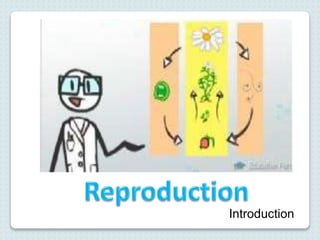
Sexual vs Asexual Reproduction: Key Differences
- 1. Introduction
- 2. Sexual and Asexual Reproduction •Reproduction is a production of a new generation of individuals (offspring) from pre existing ones (parents). •The importance of reproduction is to ensure the continuity or perpetuation of the species. •There are two types of reproduction, namely sexual and asexual.
- 3. Asexual Reproduction •This is a rapid method of increasing the number of new individuals. •The new individuals are formed from one parent and they are genetically identical to each other and to the parent. •There are five major types of asexual reproduction: a. Binary fission b. Budding c. Spore formation d. Vegetative reproduction e. Rejuvenation
- 4. •Binary fission is seen in bacteria, Amoeba and Paramecium. •The unicellular organism divides into two equal parts (daughter cells) Binary fission Binary fission in Amoeba
- 5. •Budding is seen in yeast and Hydra. •The parent produces an outgrowth or bud which detaches to become a new individual. Budding Budding in yeast
- 6. •Spore formation is seen in bacteria, fungi, mosses and ferns. •Spores are formed in spore – bearing structures called sporangium. •Spores are generally very small and light, which helps them to be dispersed by wind and water. •Each spore can develop into a new individual. Spore formation in pin mold (Mucor) Spore formation
- 7. •This type of asexual reproduction is seen in many flowering plants. •Part of a plant (root, stem, leaf or bud) detaches and grows into a new plant. Description Example Runner •A slender shoot that arises in the axil of a leaf and grows horizontally on the surface of the grounds. •The runner bears root and becomes independent before the parent plant dies. •Grass, strawberry Insert image Runner of grass Vegetative reproduction
- 8. Bulb •A bulb has a short stem and fleshy leaves containing food (mainly sugar) •It is surrounded by brown scaly leaves. •New shoots arise from buds in the axils of the fleshy leaves. •Onion, lilies Onion bulb Rhizome •A horizontally growing underground stem which stores food. •It produces lateral buds, some of which develop into shoots. •When the old rhizome dies, the new shoots become independent plants. •Canna, Ginger Rhizome of ginger
- 9. •Corm •A short, vertical, underground stem swollen with food reserves. •It is protected by scaly leaves. •Buds are located at the axils of these leaves. •Cocoyam, water chestnut Corm of cocoyam Stem tuber •The swollen ends of underground stems. •New shoots sprout out from axilary buds or “eyes” •Potato, artichoke Tuber of potato
- 10. •Rejuvenation refers to the replacement of parts of an organism that are lost due to injury. •Rejuvenation is a form of asexual reproduction if it results in two or more individuals in which there was only one before. •Animals such as sponges, flatworms and starfish are capable of rejuvenating complete organisms from parts of their bodies. •If a sponge is chopped into hundred parts, a hundred new sponges are generated. A starfish cut into half gives two starfish. Rejuvenation
- 11. Rejuvenation in Planarian (a flatworm) •Rejuvenation is common in plants. It is called vegetative propagation. Whole plants can be grown from cuttings and grafts.
- 12. Sexual Reproduction •Sexual reproduction is the production of offspring by the fusion of specialized sex cells or gametes. •The male gamete (sperm) fuses with the female gamete (ovum or egg) by a process known as fertilization. This results in the formation of a zygote. The zygote develops into a new individual. •There are two types of fertilization, internal and external.
- 13. •The internal fertilization, the sperm are deposited in the female reproductive tract and fertilization occurs within the body of the female. The zygote develops internally and live individuals are born. Internal fertilization occurs in insect, reptiles, birds and mammals. •The external fertilization, which is limited almost entirely to aquatic organisms, sperms and eggs are shed into the water in great numbers simultaneously. Only a small number of eggs are fertilized by the sperms. External fertilization occurs in most fish, amphibians and aquatic plants.
- 14. Advantages of internal fertilization over external fertilization •The eggs have a better chance of being fertilized by the sperms. Thus, there is less wastage of gametes. •The developing young receives nourishments from the female parent before the birth.
- 15. Comparison between sexual and asexual reproduction Asexual reproduction Sexual reproduction Similarity •Involves the production of a new generation of individuals of the same species.
- 16. Differences •One Number of parents involved •Usually two •No Gametes involved •Yes, two types: Male, female •Identical with parents Genetic make–up of offspring •Different from parents and they show genetic variation •Produces large numbers of offspring Offspring •Produces fewer offspring Rapid form of reproduction Speed of reproduction •Less rapid from reproduction
